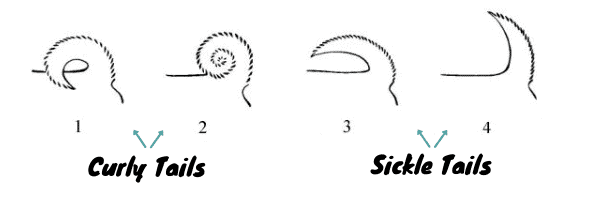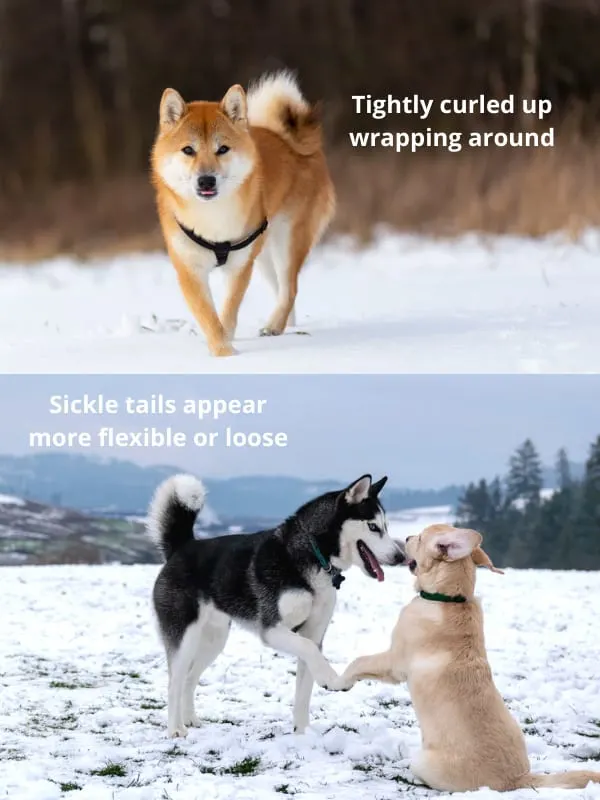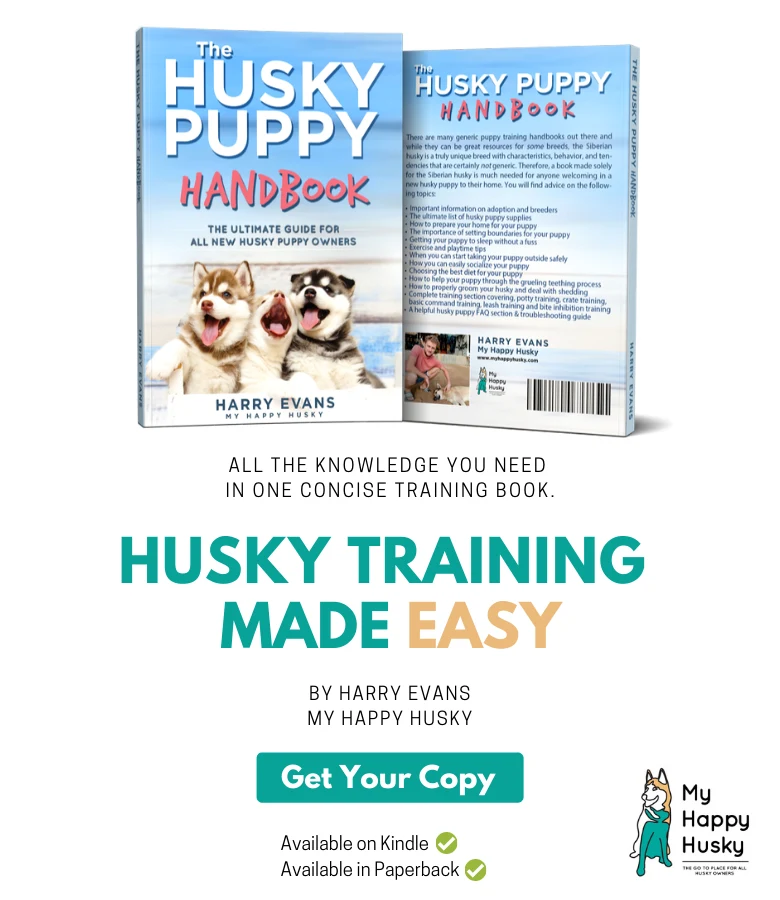This article talks all about huskies and their tails. Are they curly? Do all huskies have tails that curl? What if your husky’s tail doesn’t curl? We’ve got answers to all these questions right here!
Huskies have tails that curl to help them sleep well in really cold weather. When they lie down, their fluffy, curled tail wraps around them. It can even cover their face to keep them extra warm and safe.
Table of Contents
The Difference Between Curly & Sickle Tails
According to breed standards, huskies do not have “curly tails”, in fact, they have “sickle tails”.
This often creates confusion because we use the word “curly” to describe how curly your husky’s sickle tail is. I know… kinda weird. But that’s just how it goes.

“curly tail” dogs are those like Shiba’s or Pugs, which as you can see looks different from a husky’s tail.

*Throughout the article, I will use the word curly and sickle somewhat interchangeably as most people just use the word curly anyway. Where I need to make distinctions, I will be clear 🙂

Why Do Huskies Have Curly (sickle) Tails?
Siberian Huskies are considered a northern breed and come from the Spitz genetic family.
Most breeds in the Spitz genetic family have curly or sickle tails, which is down to the climate this breed originated from.
For example, Shibas have curled tails, and huskies have sickle tails
- Huskies were bred in Siberia and lived in arctic-like conditions for thousands of years, their furry curly tails were perfect for wrapping around over their face and head when laying down. This helped to keep them warm while resting and sleeping.
This is a common trait seen in many other northern breeds exposed to such cold climates.
Interesting read: Why is my husky so small? 4 Reasons

Do All Huskies Have Curly Tails?
No, not all huskies have curly tails. And even when they do, the “curliness” of their tails can vary dramatically.
Some huskies will have tails that do not curl at all and could be compared to the tail of a labrador. This is usually called a trailing tail.
You will also have many huskies whose tail will change from hanging down to curling up depending on their physical and emotional state.
Tails may raise up into a sickle position from a hanging position when excited and alert. The most common example of this is when you take your husky out for a walk or for his exercise, his tail will usually be held high.

The Breed Standard of Husky Tails
The AKC has a lot to say about the tail of the husky. They even compare it to the tail of a fox.
The AKC talks about huskies having a “hanging tail” or “trailing tail” when they’re relaxed or resting.
When they’re alert or paying attention, the tail should curve but not too much. They call it a “graceful sickle curve”. It won’t curl all the way over the back.
They also say the tail shouldn’t lean to the left or right. And it shouldn’t lie flat against the back either.
This is how the AKC describes the tail of a husky.
In reality, it doesn’t matter what kind of tail your furry friend has, these are just their show dog standards.
Popular Read: How much do Siberian Huskies cost?

What About Husky Puppies? Should They Have Curly Tails?
Your husky puppy’s tail will start to take shape at around 4-6 months old. But this is not a strict timeline, and tails don’t set in stone!
Husky puppies can have trailing tails but they can also have relatively curly sickle tails.
It usually depends on your husky puppy’s blood lineage and parents.
Physical traits usually pass down closely so if you were lucky enough to see both mother and father, you’ll have a pretty good idea as to how your puppy’s tail will set.
This is original content produced and published by My Happy Husky | www.myhappyhusky.com
Trending article: Miniature Huskies: Everything there is to know

Do Curly Tails Represent Quality? Purebred Status?
This is more of a subjective question, but considering how common it is, I thought I would touch on it.
In my opinion, the word “quality” starts to lead us down an overly judgemental path.
What I think, Is that whether your husky has a sickle tail or a tail that remains hanging down or trailing, it does not mean he is less or more of a “quality” husky.
It just doesn’t matter.
You can also rule out the purebred question. Some owners may question whether a husky is purebred based on his tail. While it may be an indication, that’s all it is, an indication… not a completely reliable factor. The only way to truly tell if a husky is purebred or not is to have the documents or carry out a DNA test.
Because as we discussed earlier, purebred huskies can have different tails, some always trailing, and some more sickle than others.

Last Thoughts
Huskies have what’s known as a “sickle tail”. This can often cause some confusion because we use the word curly to describe it. But having a curly tail is actually considered something else altogether.
Huskies may have sickle tails or trailing tails, and everything in between!
Most Recommended For Huskies 🐶
Best Brushes For Husky Shedding ⭐
The Furminator Undercoat Rake and a Hertzko Slicker Brush are by far the two best brushes that any husky owner should use.
Best Online Training Program For Huskies⭐
Brain Training For Dogs has become increasingly popular with Siberian Huskies in the last few years. It’s now recognized as perhaps the best way to train a husky in the most stress-free, positive way.
Best Husky Puppy Book ⭐
If you would like an easy to read guide for training your husky puppy, check out my book The Husky Puppy Handbook on Amazon. All purchases are greatly appreciated.

Disclaimer
The advice given in this article is for educational purposes only and does not constitute professional advice in any context. Before making any decisions that may affect the health and/or safety of your dog, you should always consult a trained veterinarian in your local area. For the FULL disclaimer Visit HereCopyright Notice: The content produced and published on My Happy Husky is unique and original. My Happy Husky makes an active effort to search for plagiarized content using plagiarism detection software. If plagiarized content is found, action will be taken.
